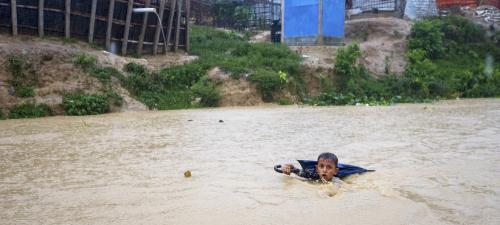Monsoon rains turn millions of children’s lives ‘upside down’ across South Asia
Heavy rainfall, severe flooding and landslides across Nepal, India and Bangladesh have killed at least 93 children, and put the lives of millions more at risk, according to the United Nations Children’s Fund (UNICEF), which is “responding urgently”.

A young boy in Bangladesh navigates a river swollen from days of monsoon rain. He is collecting plastic bottles washed into the river to sell to recyclers to help his family purchase food.
"Millions of children have seen their lives turned upside down by the torrential rainfall, flooding and landslides," Jean Gough, UNICEF Regional Director for South Asia, said on Thursday.
Estimates reveal that more than 12 million people have been affected so far. "As the rains continue, these numbers are only likely to grow," she added.
Damage to roads, bridges and railways has rendered many areas inaccessible, and children are in urgent need of clean water, hygiene supplies, food and safe play spaces in evacuation centres.
On the ground, UNICEF is working in close coordination with respective governments and humanitarian partners from the three countries to scale up its responses for affected children and their families.
“UNICEF is responding urgently, working with local authorities and partners to ensure children are kept safe, and provided the support needed”, Ms. Gough assured.
Country-by-country toll
In India, more than 10 million people have been affected in north-eastern states, including more than 4.3 million children. As the situation develops, these numbers are only likely to increase. While parts of the country have been suffering from heavy rainfall and flooding, other parts are still reeling from the aftermath of severe heat and water deficit, affecting almost half of the country.
Turning to Nepal, of an estimated 68,650 temporarily displaced people, 28,702 are children. Some 88 people have died so far, including 47 children. At least 31 people are missing, and 41 others have been injured, according to the latest Government reports. Moreover, in central and eastern Nepal, nearly 12,000 households have been temporarily displaced.
In Bangladesh, monsoon rains continue to impact most of the country, particularly the central-northern and south-east regions, where more than two million people have been affected by flooding, including over 700,500 children. Estimates reveal that 367,340 houses have been damaged or destroyed and 1,865 schools affected by flood waters. Cox's Bazar in the south-east of the country, home to more than a million Rohingya refugees, has also been heavily hit.
Children pay ‘the heaviest price’
While individual extreme weather events cannot specifically be attributed to climate change, said UNICEF, the increasing frequency and severity of extreme weather – including recent high temperatures, intense rains and slow-moving fronts – are in line with predictions of how human activity is influencing the global climate.
In addition to death and devastation, such events contribute to the increased spread of malnutrition, malaria and diarrhea, among other major killers.
"Across the region, we are seeing the devastating impact of extreme weather events on children and families,” warned Ms. Gough. "As weather events become more extreme, unpredictable and erratic, it is children who are paying the heaviest price.”
Source:UN
- 206 reads
Human Rights
Ringing FOWPAL’s Peace Bell for the World:Nobel Peace Prize Laureates’ Visions and Actions

Protecting the World’s Cultural Diversity for a Sustainable Future

The Peace Bell Resonates at the 27th Eurasian Economic Summit

Declaration of World Day of the Power of Hope Endorsed by People in 158 Nations

Puppet Show I International Friendship Day 2020

